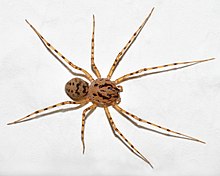| This article needs additional citations for verification. Please help improve this article by adding citations to reliable sources. Unsourced material may be challenged and removed. Find sources: "Scytodes thoracica" – news · newspapers · books · scholar · JSTOR (March 2024) (Learn how and when to remove this message) |
| Scytodes thoracica | |
|---|---|

| |
| Scientific classification | |
| Domain: | Eukaryota |
| Kingdom: | Animalia |
| Phylum: | Arthropoda |
| Subphylum: | Chelicerata |
| Class: | Arachnida |
| Order: | Araneae |
| Infraorder: | Araneomorphae |
| Family: | Scytodidae |
| Genus: | Scytodes |
| Species: | S. thoracica |
| Binomial name | |
| Scytodes thoracica (Latreille, 1802) | |
| Synonyms | |
| |
Scytodes thoracica is a spitting spider, so called because it spits a venomous sticky silken substance over its prey. Its size ranges between 3–6 mm (0.12–0.24 in). The carapace is unusual in sloping upwards towards its rear end, whereas the abdomen slopes downwards.
It has six eyes instead of the eight spiders usually have. It has a wide distribution: found in "Europe, North Africa, Turkey, temperate Asia to China, Korea, Japan. Introduced to North America, Argentina, India, Australia, New Zealand."
This particular spitting spider features the presence of silk glands in its cephalothorax. Besides the silk glands in its abdomen, the spider also has silk glands connected with its venom glands. In this way the spider has the ability to make venomous silk. Other arachnids may also have silk glands in their cephalothorax, such as the pseudoscorpions.
Hunting tactics
| This section includes a list of references, related reading, or external links, but its sources remain unclear because it lacks inline citations. Please help improve this section by introducing more precise citations. (March 2024) (Learn how and when to remove this message) |

In contrast to the pseudoscorpions that use the silk from the cephalothorax glands to make nests, the spitting spider uses it to catch prey in a very particular way. It is a very slow hunter as its long and tender legs may suggest. During night, when some insects are less active, Scytodes starts its hunt. The spider sneaks very carefully towards its prey and, from about 10 mm (0.39 in), stops and carefully measures the distance to its prey with one front leg without disturbing it. Then it squeezes the back of its body together and spits two silk threads, in 1/600 s, in a zigzag manner over the victim. The prey is immediately immobilized. When the prey is larger the spider spits several times. It is assumed the spider uses special long hearing hairs located at its legs to locate its prey.
Habitat
| This section includes a list of references, related reading, or external links, but its sources remain unclear because it lacks inline citations. Please help improve this section by introducing more precise citations. (March 2024) (Learn how and when to remove this message) |
Scytodes thoracica is nocturnal. It prefers warm temperatures and is not rare inside houses. In Southern Europe, it can be found under stones outside houses. In Northern Europe it can only be found in houses. They can be found worldwide.
Reproduction
| This section includes a list of references, related reading, or external links, but its sources remain unclear because it lacks inline citations. Please help improve this section by introducing more precise citations. (March 2024) (Learn how and when to remove this message) |
The mother makes a nursery web for the emerged spiderlings, and carries her eggs under her belly in a net of silk.
References
- "Scytodes thoracica". World Spider Catalog. Retrieved 22 August 2017.
External links
- Photographs of Scytodes thoracica
- Info and pictures of Scytodes thoracica
- A Spitting spider from North Austin, Texas
| Taxon identifiers | |
|---|---|
| Scytodes thoracica |
|
This article related to araneomorph spiders is a stub. You can help Misplaced Pages by expanding it. |